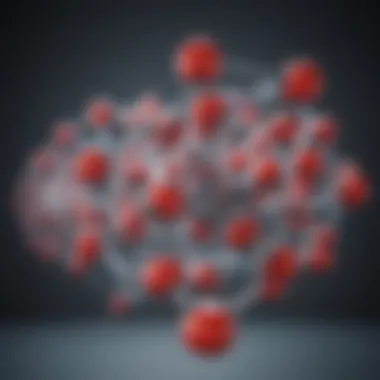Platinum Drugs in Cancer Treatment: An Overview


Intro
Platinum-based drugs have transformed the landscape of oncology, offering new avenues for cancer treatment. Their introduction has marked a significant milestone in medical science, emphasizing the need for ongoing research and development in the field. Among these compounds, cisplatin and carboplatin are the most recognized, known for their efficacy against various types of cancer, including testicular and ovarian carcinomas.
As we delve into the mechanisms of action, clinical applications, side effects, and emerging trends related to platinum drugs, it becomes crucial to appreciate not just their impact but also the challenges they pose, including drug resistance. This discussion will provide a comprehensive overview that spans historical context and modern advancements, aiming to enhance the understanding of students, researchers, educators, and professionals in the field.
Prelude to Platinum Drugs in Oncology
Platinum drugs have had a significant impact in the field of oncology, proving to be game-changers in cancer treatment. Their unique mechanisms of action and efficacy against various malignancies underscore their importance. This article will explore essential aspects of platinum drugs, such as their historical development, their role in cancer therapy, and recent advancements.
The relevance of discussing platinum drugs cannot be overstated. Many patients suffer from types of cancer that respond poorly to traditional therapies. Platinum-based agents, like cisplatin, have been effective against solid tumors. Understanding their role helps clinicians make informed decisions regarding treatment plans.
Historical Development of Platinum Compounds
The journey of platinum compounds in cancer treatment began in the 1960s when scientists serendipitously discovered the antitumor properties of cisplatin. Initially synthesized in 1845 by the chemist Michele Peyrone, it took over a century for its potential in oncology to be recognized. The compound was primarily used in the 1970s after preclinical studies revealed significant antitumor activity. Over time, research led to the development of related compounds, most notably carboplatin and oxaliplatin. These new drugs offered varying efficacy and toxicity profiles, broadening the scope of treatment options available to oncologists.
The body of evidence supporting platinum compounds has generated a substantial number of publications and clinical trials. This historical context assists in understanding the trajectory of research and development in this field. By analyzing past advancements, we can appreciate the ongoing innovations that continue to emerge.
Significance in Cancer Therapy
Platinum drugs are crucial in modern cancer therapy for several reasons. They are effective against a variety of tumors, including testicular, ovarian, and non-small cell lung cancers. Studies consistently demonstrate that these compounds can improve survival rates and manage symptoms effectively. The ability to combine platinum-based therapies with other treatments further enhances their utility, increasing the overall effectiveness of therapeutic regimes.
One of the key attributes of platinum drugs is their mechanism of action. They interact with DNA, forming cross-links that prevent cell division and induce apoptosis. This makes them particularly potent, as cancer cells are especially vulnerable to such genetic disruptions.
“Understanding the mechanisms and significance of platinum drugs is essential for advancing cancer treatment methodologies.”
Mechanisms of Action
Understanding the mechanisms of action of platinum drugs is essential in appreciating their role in cancer therapy. These drugs, particularly cisplatin, carboplatin, and oxaliplatin, work in unique ways to interfere with the ability of cancer cells to multiply and survive. This section will delve into three primary mechanisms: their interaction with DNA, the induction of apoptosis, and their effects on the cell cycle. By grasping these mechanisms, one can appreciate the therapeutic potential and limitations of platinum-based treatments.
DNA Interaction
Platinum drugs primarily exert their anticancer effects through their interactions with DNA. The cornerstone of their action lies in forming DNA cross-links, which are critical for impeding cellular replication. When a platinum compound enters a cell, it gets activated and binds to the DNA molecule, leading to the formation of bifunctional adducts. These adducts inhibit the separation of DNA strands, halting the cell’s ability to replicate properly.
The significance of this binding is profound. By disrupting DNA structure, platinum drugs instigate cellular stress responses. This may lead to the activation of repair mechanisms, but if these pathways are overwhelmed, cell death can occur. Notably, such mechanisms often explain the lethality of these drugs against rapidly dividing cancer cells, which are more susceptible to the permanency of the DNA damage these agents induce.
Induction of Apoptosis
The process of apoptosis, or programmed cell death, is another vital mechanism through which platinum drugs exert their action. Once platinum drugs bind to DNA and form adducts, it triggers a cascade of intracellular signals that lead to apoptosis. Cells that have sustained significant DNA damage often activate apoptosis to eliminate the threat they pose due to potential mutations.
Research indicates that platinum compounds can influence various signaling pathways, including the p53 protein pathway, which is crucial in determining cell fate following DNA damage. When apoptosis is induced, it effectively removes damaged cells, thereby limiting the proliferation of cancerous cells. However, the efficiency of this mechanism can vary between different cancer types and individual patients, often resulting in a challenge in treatment efficacy and resistance.
Cell Cycle Effects
The effects on the cell cycle are intricately related to the action of platinum drugs. The binding of these compounds to DNA not only triggers apoptosis but also influences the phases of the cell cycle. Particularly, platinum drugs can stall cells in the G2/M phase, where DNA damage is assessed before mitosis occurs. This disruption is critical as it provides an opportunity for cells to repair the damage before division.
This characteristic is useful in combination therapy approaches, where platinum compounds are paired with other agents that restrict cell cycle progression. By synchronizing the action of drugs, oncologists can enhance the cytotoxic effects on tumor cells while limiting toxicity to normal cells. Understanding the dynamics of how these drugs interact with the cell cycle provides invaluable insights into optimizing treatment regimens for various cancers.
Key Platinum Compounds
Platinum compounds play a pivotal role in the landscape of cancer therapy. These agents possess unique characteristics that make them particularly effective against various malignancies. Among them, cisplatin, carboplatin, and oxaliplatin are the notable drugs, each with distinct properties, advantages, and specific applications. Understanding these compounds helps in appreciating their relevance and significance in oncology.
Cisplatin
Clinical Indications


Cisplatin is one of the most commonly used platinum drugs. Its primary clinical indications include testicular cancer, ovarian cancer, bladder cancer, and non-small cell lung cancer. The efficacy of cisplatin lies in its ability to cause DNA cross-linking, hindering cancer cell replication. Its deep-rooted history in treating various cancers underscores its vital role in oncological protocols. Cisplatin’s versatility and established guidelines for usage emphasize its contribution to improving patient outcomes.
Efficacy and Limitations
Cisplatin is recognized for its high efficacy, particularly in advanced testicular cancer, leading to long-term remission in many cases. However, its limitations are significant. One major drawback is the occurrence of drug resistance, as many tumors develop mechanisms to evade cisplatin's effects. Moreover, its nephrotoxicity can limit its use, requiring careful monitoring of kidney functions during treatment. Understanding both its efficacy and limitations allows clinicians to better tailor treatment plans to their patients' needs.
Side Effects
The side effects of cisplatin include nausea, vomiting, and potential neurotoxicity. While these adverse effects are manageable with supportive care, they can impact the patient’s quality of life. The risk of hematologic toxicities further complicates its usage. Awareness of side effects helps healthcare professionals mitigate risks and monitor patients effectively throughout their treatment.
Carboplatin
Comparison with Cisplatin
Carboplatin was developed as a less toxic alternative to cisplatin. Its mechanism allows for a similar form of DNA cross-linking but with a different side effect profile. Carboplatin generally has a lower risk of nephrotoxicity, making it a suitable alternative for patients with pre-existing kidney issues. However, it can lead to increased myelosuppression. Understanding the balance between effectiveness and toxicity when comparing these two compounds is crucial for selecting appropriate chemotherapy regimens.
Usage in Specific Cancers
Carboplatin is especially beneficial in treating ovarian cancer, often used in combination with other agents. Its effectiveness in this specific context showcases its importance in oncological protocols. Its adaptability in combination therapies enhances its utility in various cancer types, making it a go-to choice for oncologists confronting challenging cases.
Toxicity Profile
The toxicity profile of carboplatin is differentiated by its hematological side effects, notably thrombocytopenia, which can result in bleeding complications. Comparing its toxicity with cisplatin illustrates how patient-specific factors can influence treatment decisions. This difference underlines the need for individualized treatment approaches to optimize outcomes while minimizing risks.
Oxaliplatin
Mechanisms of Action
Oxaliplatin operates through similar mechanisms as cisplatin but exhibits a unique effectiveness against colorectal cancer. The drug forms DNA cross-links but has a different action on cellular repair mechanisms as well. This makes it a key player in combination with other chemotherapeutics for treatment regimens targeting colorectal malignancies. Understanding its mechanisms provides insight into its role in enhancing the effectiveness of cancer treatment.
Applications in Colorectal Cancer
Oxaliplatin is primarily applied in the treatment of colorectal cancer, often in combination regimens. Its introduction has significantly improved outcomes for patients with this cancer type, especially in advanced stages. Knowing its specific applications helps in forming effective treatment plans and enhances the chances of patient response.
Adverse Effects
The adverse effects of oxaliplatin include peripheral neuropathy, which can persist after treatment completion. While this side effect poses challenges in managing long-term quality of life, the overall benefits of oxaliplatin in controlling colorectal cancer progression cannot be overlooked. Awareness of these effects helps healthcare providers in monitoring and offering supportive measures to patients during and after therapy.
In summary, understanding the key platinum compounds is essential for anyone involved in cancer treatment. Each compound has its distinct mechanisms, applications, and side effects, necessitating a detailed understanding to select the most appropriate therapy for patients.
Clinical Applications and Treatment Regimens
The role of platinum drugs in clinical applications and treatment regimens is crucial. These drugs are frequently prescribed due to their effectiveness against various forms of cancer. Oncology clinicians must thoughtfully consider how to integrate these compounds into treatment plans. The rationale lies in their ability to enhance the efficacy of other therapeutic modalities while managing toxicity. This section will elucidate on the synergistic effects of platinum drugs, particularly in how they navigate the complexities of cancer treatment.
Combination Therapies
With Other Chemotherapeutics
Platinum drugs often form the backbone of combination chemotherapy regimens. They enhance therapeutic effects when paired with other chemotherapeutics such as paclitaxel or doxorubicin. This approach can lead to increased cancer cell death compared to monotherapy.
A key characteristic of these combinations is their ability to target different pathways, creating a multitargeting strategy against cancer. This is beneficial for patients who may develop resistance when subjected to single-agent therapies.
However, it is essential to manage potential overlaps in toxicity. For instance, both platinum drugs and other agents may cause myelosuppression. Patients should be monitored closely for these side effects while on treatment, ensuring that the benefits outweigh the risks.
Targeted Agents


Targeted agents represent another important ally for platinum drugs. This combination strategy enhances treatment efficacy by exploiting specific molecular targets on cancer cells. For example, using platinum drugs alongside targeted therapies like trastuzumab can lead to improved outcomes in HER2-positive breast cancer.
The unique feature of targeting specific molecular pathways is that it can provide benefits for oncologists in personalizing treatments for patients. However, the challenges remain, especially regarding the development of resistance to targeted agents. Careful patient selection is crucial when devising these treatment plans.
Neoadjuvant and Adjuvant Settings
Neoadjuvant and adjuvant settings play a significant role in optimizing patient outcomes. Neoadjuvant chemotherapy is administered prior to surgery, aiding in the downsizing of tumors. This can allow for more successful surgical resections. In contrast, adjuvant therapy is provided post-surgery to eliminate residual disease. Both strategies highlight the versatility of platinum-based drugs in treatment regimens.
Specific Cancers Treated
Testicular Cancer
Testicular cancer has shown a particularly strong response to platinum drugs. Cisplatin is the cornerstone of treatment for this malignancy. The regimen involving bleomycin and etoposide, commonly known as BEP, demonstrates the effectiveness of platinum drugs in this area.
The significant efficacy in testicular cancer stems from the sensitivity of germ cell tumors to this treatment modality, leading to high cure rates. However, it is vital to monitor long-term side effects, such as possible cardiovascular issues from chemotherapy exposure.
Ovarian Cancer
Ovarian cancer frequently utilizes carboplatin as part of the standard treatment regimen. The combination of carboplatin and paclitaxel has become a widely accepted approach. The advantage lies in the ability to manage symptoms while prolonging survival, even in advanced stages of the disease.
Nevertheless, patients should be cautious of the risk of recurrence. Continuous follow-up is essential to monitor for signs of disease return.
Non-Small Cell Lung Cancer
In non-small cell lung cancer, platinum-based regimens, particularly involving cisplatin or carboplatin, are common. These drugs are integrated into therapeutic combinations with agents such as pemetrexed or gemcitabine.
The benefit of using platinum drugs in this context is their ability to enhance overall survival rates. Yet, clinicians need to carefully assess patient comorbidities and overall health status, as these factors can affect treatment tolerance and effectiveness.
Platinum drugs play a central role in cancer therapy, offering substantial benefits when used in combination with effective agents across various cancer types.
Resistance Mechanisms
Resistance mechanisms in platinum drug therapy play a critical role in the effectiveness of cancer treatment. Understanding these mechanisms is essential for optimizing existing therapies and developing new strategies to overcome resistance. As oncology continues to evolve, recognizing resistance can lead to more tailored and effective patient care.
Pharmacokinetic Factors
Pharmacokinetics involves how the body absorbs, distributes, metabolizes, and excretes drugs. In the case of platinum compounds, several factors can impact their therapeutic efficacy.
- Absorption: When platinum drugs are administered, their absorption rates can affect how much of the drug reaches the target tissues. Factors like formulation and delivery methods influence this process.
- Distribution: After administration, how the drug spreads throughout the body is crucial. These drugs might accumulate in certain tissues or organs, impacting their efficiency at the tumor site.
- Metabolism: Platinum drugs undergo various metabolic processes. Some cancer cells may acquire enzymes that modify these drugs, rendering them less effective.
- Elimination: The rate at which platinum compounds are eliminated from the body can also lead to resistance. If drugs are removed quickly, the therapeutic window may not be sufficient for effective treatment.
In summary, pharmacokinetic factors can create variability in treatment outcomes, thus contributing to resistance in some patients while others may respond well.
Cellular Repair Mechanisms
Cancer cells possess potent mechanisms to repair damage caused by platinum drugs. When platinum compounds bind to DNA, they form adducts that interfere with replication and transcription. However, cancer cells can activate several repair pathways:
- Nucleotide Excision Repair (NER): This is one common pathway that removes damaged DNA segments, allowing for potential recovery from platinum-induced damage.
- Base Excision Repair (BER): Another prominent pathway, BER can fix minor lesions in DNA. If platinum damages are perceived as such, the cancer cells may utilize this to avoid apoptosis.
- Homologous Recombination (HR): This method repairs double-strand breaks effectively. Cancer cells that overexpress proteins involved in HR often demonstrate increased resistance.
Understanding these repair mechanisms is essential for developing combination therapies that can impede these pathways, potentially restoring sensitivity to platinum drugs.
Role of Tumor Microenvironment
The tumor microenvironment is the surrounding cellular matrix, supporting cells, and various signaling molecules. Its role in resistance mechanisms is increasingly recognized. Factors within the microenvironment affecting resistance include:
- Hypoxia: Low oxygen levels can enhance cancer cell survival and promote resistance. Hypoxic conditions may render platinum drugs less effective by hindering drug activation.
- Intercellular Signaling: Tumors often release factors that induce resistance. Signaling pathways activated by neighboring cells can enhance the cancer cell's survival strategies.
- Immune Response Alteration: The tumor microenvironment can modulate immune responses. This may help overcome the body’s ability to combat damaged cells after platinum therapy.


New Formulations and Delivery Methods
In the evolving field of oncology, the development of new formulations and delivery methods for platinum drugs has become crucial. As the understanding of cancer biology improves, so does the need for more effective ways to administer these drugs. New methods aim to enhance the therapeutic index and reduce associated side effects. Moreover, they also tackle the issue of drug resistance, a significant challenge in cancer treatment.
Effective delivery systems can improve the bioavailability of platinum compounds, ensuring that a higher concentration reaches the tumor site while minimizing exposure to healthy tissue. This tailored approach allows for more precise treatments, ultimately resulting in better outcomes for patients.
Nanoparticle-based Delivery
Nanoparticle-based delivery systems represent a frontier in the administration of platinum drugs. These systems often utilize nanoparticles to encapsulate the drug, allowing for controlled release. This is particularly valuable in managing the pharmacokinetics of drugs like cisplatin and carboplatin. With these formulations, it is possible to extend the circulation time of the drug in the bloodstream, leading to enhanced uptake by tumors.
Some key advantages include:
- Improved Targeting: Nanoparticles can be designed to target specific cancer cells, increasing effectiveness and minimizing damage to healthy cells.
- Reduced Toxicity: By controlling drug release, side effects may be lessened, improving patient quality of life.
- Combination Therapies: Nanoparticles can carry multiple agents, facilitating combination treatments that can enhance overall efficacy.
Developments in this area are ongoing, with research focusing on various materials, such as lipids and polymers, to create optimal delivery systems.
Liposome Encapsulation
Liposome encapsulation is another innovative approach for the delivery of platinum drugs. Liposomes are spherical vesicles made of lipid bilayers that can encapsulate drugs, allowing for effective delivery into the body. This method shows promise in increasing the solubility of hydrophobic drugs like cisplatin, along with improving bioavailability.
The benefits of liposome encapsulation are significant:
- Enhanced Stability: Liposomal formulations can protect drugs from premature degradation, ensuring they reach their destination.
- Improved Absorption: Liposomes can facilitate cellular uptake, allowing for more effective action against cancer cells.
- Reduced Immunogenicity: Encapsulation can help modulate the immune response, leading to reduced clearance rates and prolonged action of the drugs in the body.
Current studies are exploring various types of liposomal formulations and combinations with other therapeutic agents to optimize cancer treatment regimens. As more is understood about the interactions between these formulations and tumor biology, further innovations are expected.
"Innovations in nanoparticle and liposome technologies are paving the path for enhanced delivery of platinum compounds, potentially transforming cancer treatment strategies."
Future Perspectives
The future of platinum drugs in cancer treatment is a critical topic, with ongoing research and clinical trials shaping the landscape. Understanding the potential advancements not only enhances our grasp of therapeutic strategies but also addresses the pressing challenges faced in oncology. The evolution of these compounds signifies possibilities for improved efficacy and reduced toxicity.
Ongoing Research and Clinical Trials
Current studies focus on optimizing existing platinum compounds and exploring new formulations. Researchers are examining how drug combinations might enhance therapeutic outcomes while minimizing adverse effects. For instance, clinical trials are evaluating the efficacy of carboplatin in tandem with targeted therapy agents. This approach allows for a more personalized treatment landscape.
- Biomarker Research: There is an increasing emphasis on identifying biomarkers that predict responses to platinum drugs. Understanding individual patient profiles can lead to more tailored treatment regimens.
- New Compounds Exploration: Investigational drugs, such as satraplatin, are being researched for potential benefits over traditional options. These alternatives may offer different mechanisms or side effect profiles.
"The quest for better treatments is unending. Research and trials are at the forefront of improving patient experiences and outcomes."
- Clinical Trials Landscape: More than 300 current trials focus on platinum drugs alone or in combination with other therapies. This indicates strong academic and pharmaceutical interest in advancing cancer treatment.
Innovations in Combination Approaches
Combination therapies are capturing significant attention in oncology due to their promise of enhanced effectiveness. Using platinum drugs alongside other modalities can target multiple pathways in cancer cells. This multi-faceted approach seeks to overcome resistance mechanisms that often limit single-agent therapies.
- Targeted Therapies: Platinum drugs combined with agents that focus on specific cancer pathways are a prominent area of research. For example, pairing cisplatin with monoclonal antibodies has shown potential in increasing treatment effectiveness in specific tumor types.
- Immunotherapy Integration: Researchers are also studying how integrating platinum compounds with immunotherapies may elevate immune responses against tumors, enhancing overall patient outcomes.
In summary, future perspectives surrounding platinum drugs reflect a dynamic and evolving field. With ongoing research and innovation in combination therapies, the potential for enhanced treatment regimens continues to grow.
Ending
In the context of platinum drugs and their critical role in cancer treatment, the conclusion serves as a vital component that synthesizes the extensive information discussed throughout the article. It highlights not only the historical journey of platinum-based compounds but also their evolving significance in contemporary oncology.
Platinum drugs, such as cisplatin, carboplatin, and oxaliplatin, have shown remarkable efficacy against several cancer types. Understanding their mechanisms of action—particularly how they interact with DNA and induce apoptosis—provides essential insights into their therapeutic value. Evaluating combination therapies and resistance mechanisms reflects the complexity and adaptability needed in modern cancer treatment approaches.
Further, new formulations and delivery methods, including nanoparticle-based techniques and liposome encapsulation, are crucial for enhancing the effectiveness and reducing toxicity of these therapies. The ongoing research and innovations in combinatorial strategies underscore the potential for improving patient outcomes.
For students, researchers, educators, and professionals in oncology, grasping the relevance of platinum drugs is fundamental. They not only represent historical advancements but also signify ongoing efforts to create more effective and targeted therapeutic options. By nurturing an understanding of these elements, one can appreciate the intricate landscape of cancer treatment and the promising future that lies ahead.
Investment in platinum drug research may redefine treatment protocols and improve the quality of life for countless patients.
Ultimately, this conclusion serves as a reminder of the importance of continuous learning and adaptation in the pursuit of effective cancer therapies. The possibilities for enhancing therapeutic outcomes remain boundless, driven by sustained research and innovation in the field.



